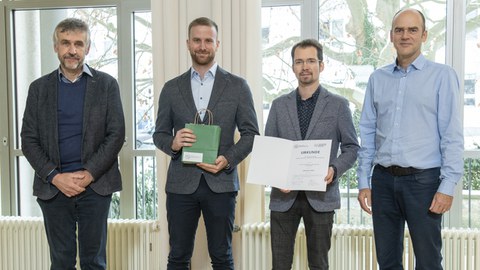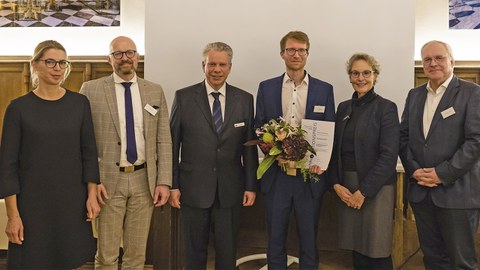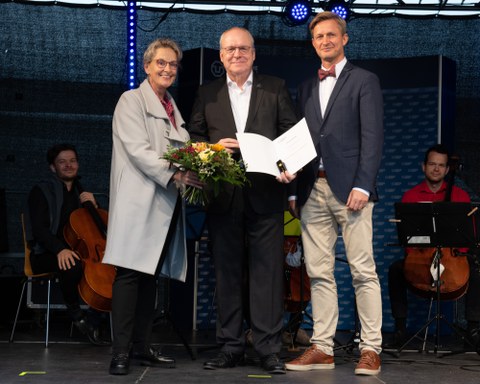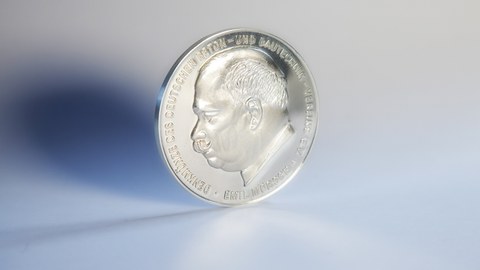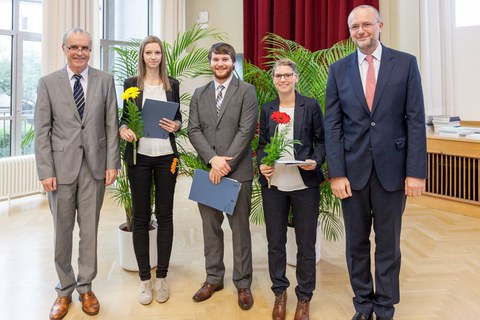Awards
Kurt Beyer Prize 2024

Adrian Diaconu (HOCHTIEF Infrastructure GmbH, Deutschland Südost) und der Prorektor Forschung Prof. Dr. Lars Bernard übereichen den Preis an Josiane Herfort
Dr.-Ing. Josiane Herfort (Faculty of Civil Engineering) receives the Kurt Beyer Prize 2024 for her dissertation: "Stability sensitivity of thin-walled structures made of carbon-reinforced concrete".
News report: Kurt Beyer Prize 2024
Rüsch Research Prize 2025

Preisverleihung Rüsch-Forschungspreis 2025
The prestigious Rüsch Research Prize of the German Concrete and Construction Technology Association E.V. (DBV) will be awarded in 2025 to three young researchers who have impressed the jury with their outstanding scientific achievements in the field of concrete construction. The award ceremony took place on March 20, 2025 as part of the opening event of the German Construction Technology Day in Stuttgart. The jury particularly emphasized the consistently extraordinarily high scientific quality and the high innovation potential of all submitted works and recognized this for the first time with three awards.
The 2nd place of the Rüsch Research Award 2025 with prize money of € 2,500 each went to two young researchers. Dr.-Ing. Lena Leicht took 2nd place with her dissertation "Characterization of Mineral-Bonded Composites As Damping Layers Against Impact Loading", which she submitted to the Faculty of Civil Engineering at Dresden University of Technology. Dr.-Ing. Homam Spartali, RWTH Aachen, also took 2nd place.
You can find more information on the Rüsch Research Prize at betonverein.de/ruesch-forschungspreis.
Kurt Beyer Prize 2023
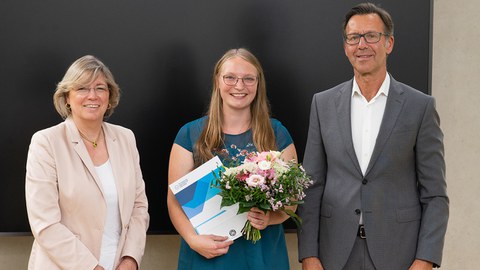
Die Prorektorin Forschung Prof. Dr. Angela Rösen-Wolff und Adrian Diaconu (HOCHTIEF Infrastructure GmbH, Deutschland Südost) übereichen den Preis an Lena Leicht
Dr.-Ing. Lena Leicht (Faculty of Civil Engineering) receives the Kurt Beyer Prize 2023 for her dissertation: "Characterization of mineral-bonded composites for impact attenuation".
News report: Kurt Beyer Prize 2023
Bautag 2024 - Awards from the East German construction industry for graduates from the Institute of Concrete Structures

Die Preisträger mit Ihren Betreuern (v.l.n.r.) Prof. Steffen Marx, Dr.-Ing. Oliver Mosig, Fabian Schülke, Sebastian Thiele und Max Herbers M.Sc.
On 24.05.2024, the Bauindustrieverband Ost e. V. invited to its traditional Construction Day in Dresden. Two of the four prizes went to students whose work was produced at the Institute of Concrete Structures.
News report: Prize of the Bauindustrieverband Ost e. V.
Research in the mesh lattice girder project honored with the Techtextil Award 2024
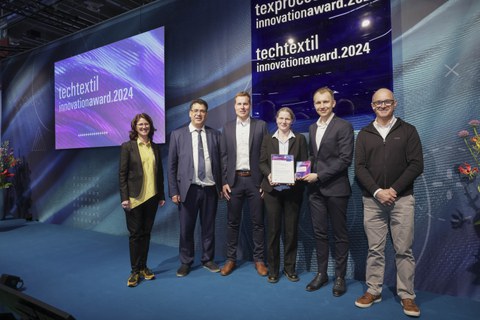
ITM und IMB als Preisträger des Techtextil-Award 2024, v.l.n.r: Sabine Scharrer (Techtextil), Chokri Cherif (ITM), Lars Hahn (ITM), Birgit Beckmann (IMB), Paul Penzel (ITM), António Braz Costa (Jury)
The ITM and the IMB have been awarded the Techtextil Award 2024 for their joint research in the project Netzgitterträger on 23.04.2024 in Frankfurt/Main. Congratulations to Harald Michler, Nazaib Ur Rehman, Marina Stümpel, Birgit Beckmann, Steffen Marx and Manfred Curbach! A wonderful example of how interdisciplinary collaboration with textile technology colleagues can lead to outstanding results.
News report: Research in the mesh lattice girder project honored with the Techtextil Award 2024
Dissertation prize from the Commerzbank Dresden Cultural Foundation
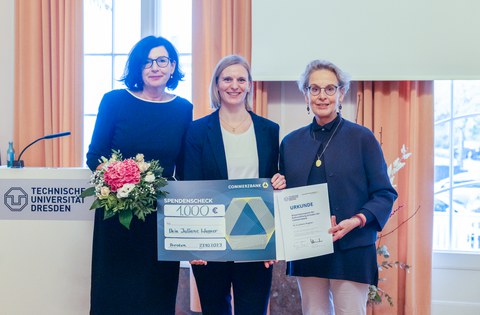
Von links: Beate Sopart als Vertreterin der Geschäftsleitung der Commerzbank AG Dresden, Preisträgerin Dr. Juliane Wagner, Fakultät Bauingenieurwesen, Prof. Dr. Ursula Staudinger, Rektorin der TU Dresden. Foto: Oliver Killig
On October 27, Dr. Juliane Wagner received the dissertation prize from the Commerzbank Dresden Cultural Foundation for her dissertation "On the load-bearing behaviour of carbon concrete under fatigue loading". The award was presented by the Rector of TU Dresden, Prof. Dr. Ursula Staudinger, and Beate Sopart, representing the management of Commerzbank AG Dresden, at a ceremony in the ceremonial hall of the University Executive Board. The prize is endowed with 1000 euros.
News report: Dissertation prize of the Commerzbank Dresden Cultural Foundation
Kurt Beyer Prize 2022
Dr. Oliver Steinbock (Faculty of Civil Engineering) receives the Kurt Beyer Prize 2022 for his dissertation: "Reinforcement of reinforced and prestressed concrete bridges with carbon concrete".
News report: Kurt Beyer Prize 2022
fib Medal of Merit for Prof. Manfred Curbach
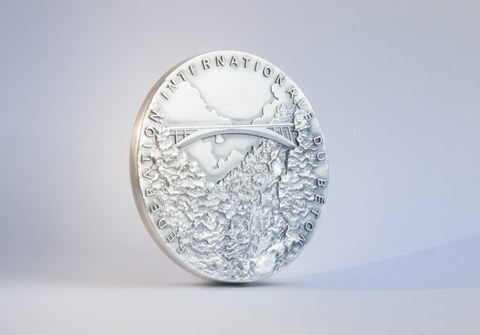
fib Medal of Merit 2023
The fib - International Federation for Structural Concrete - Fédération Internationale du Béton awards the fib Medal of Merit to Prof. Manfred Curbach at the start of the Ulm Concrete Days 2023 - in recognition of his outstanding contributions to structural concrete construction and to fib.
Teaching Award 2022
On December 14, 2022, as part of the Senate meeting, Prof. Steffen Marx, Peter Betz and Conrad Pelka received the Teaching Award 2022 for the lecture and the seminar "Reinforcement of Solid Structures".
News report: Teaching award 2022
Innovation Award 2021 of the Industrieclub Sachsen e. V. for Oliver Steinbock
On 15.11.2022, the Innovation Award 2021 was presented to Dr.-Ing. Oliver Steinbock, he is the proud 30th prize winner. He received the prize, endowed with 5000 euros, for his doctoral thesis at TU Dresden, in which he researched how carbon concrete can be used to renovate dilapidated bridges.
News report: Innovation prize 2021 for Oliver Steinbock
Kurt Beyer Prize 2021
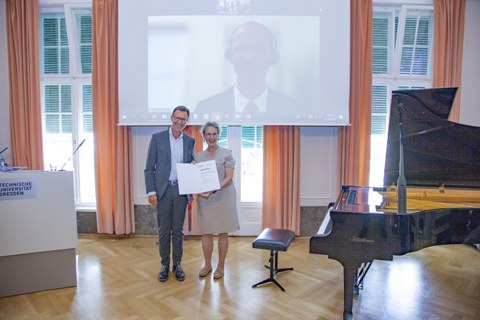
Adrian Diaconu (Vertretung Hochtief bzw. Stifter des Preises), Rektorin und Preisträger Dr. Michael Frenzel, Fakultät Bauingenieurwesen, per Videokonferenz
Dr. Michael Frenzel (Faculty of Civil Engineering) receives the Kurt Beyer Prize 2021 for his dissertation "On the load-bearing behavior of lightweight, layered concrete slabs". The work provides an overview of the current state of development and existing research work on layered, sandwich-type concrete slabs. It deals with the properties of concrete, steel and reinforced concrete and in detail with the bond between concrete layers, which has a particular influence on the load-bearing capacity of layered concrete floors. Various component states are then explained and the types of failure that can occur in layered elements are presented. These mainly include bending tension and bending compression failure as well as bending shear and joint failure. Formulas are provided for calculating deflections in service as well as breaking loads depending on the type of failure. Calculation approaches for the assessment of the component condition due to the different shrinkage of the concretes are also listed.
Bridge made of carbon concrete awarded: double honor for the structure by Fédération internationale du béton (fib)

Marc Koschemann, Iurii Vakaliuk (v.n.l.r.) präsentieren stolz die Urkunden
Oslo/Dresden: It bears the name CarboLight Bridge and combines sleek design and resource conservation. The bridge made of carbon concrete and infra-lightweight concrete was specially designed and built for the Deutsches Museum by scientists from the Institute of Concrete Structures at TU Dresden. The bridge has taken its place in the newly designed bridge and hydraulic engineering department of the Deutsches Museum following the general refurbishment and impressively demonstrates the advantages of the innovative combination of materials.
The bridge received two awards at the fib Congress, which took place in Oslo from June 12 to 16, 2022: the special prize Exceptional Recognition in the "Award for Outstanding Concrete Structures" competition and the Innovation Award 2022 in the "Structures" category for the paper "An ultra-light Carbon Concrete Bridge: From Design to Realization" by authors Marc Koschemann, Iurii Vakaliuk and Manfred Curbach.
News report: CarboLight Bridge receives award
Construction Industry East Award for Josiane Giese
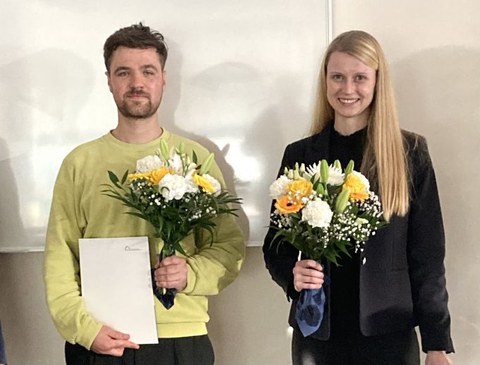
Die Preisträger in der Kategorie “Architektur” Quentin Pagés und in der Kategorie „Bauingenieurwesen“ Josiane Giese
As an important signal of securing the future, the Bauindustrieverband Ost e. V. awarded its industry prize to graduates in the field of Civil Engineering and Architecture at the association's internal meeting of the Personnel Development Committee on November 9, 2021 in Leipzig, even in these particularly difficult corona times. Josiane Giese was honored with the award in the Civil Engineering category for her diploma thesis "Experimental investigation of a carbon concrete reinforced slab bridge". The capabilities of carbon concrete were demonstrated in the reinforcement of a bridge structure and the effectiveness of the strengthening measure was proven. The successful application of carbon concrete reinforcement in bridge construction is an important contribution to further research and the establishment of this construction method in practice.
Badge of Honor 2020 for Prof. Manfred Curbach
On October 4, 2021, Prof. Manfred Curbach received a 2020 Golden Badge of Honor from TU Dresden as part of the staff celebration. Manfred Curbach has done pioneering work in the field of textile and carbon concrete and was responsible for the Prorectorate for University Development at TUD Dresden University of Technology for one term of office with great success. Prof. Manfred Curbach stands for interdisciplinarity, internationality and successful technology transfer in equal measure. The Golden Badges of Honor are awarded to members of TU Dresden who have rendered outstanding services to the university through exceptional merits and special individual achievements.
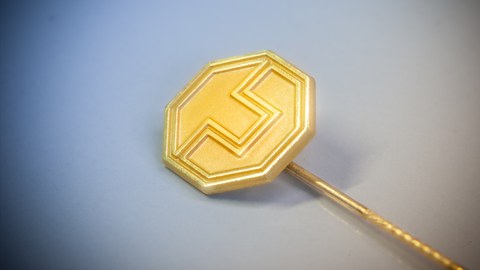
Goldene Ehrennadel 2020 der Technischen Universität Dresden
Award of the Construction Industry Saxony for outstanding theses in the field of Civil Engineering and Architecture 2020
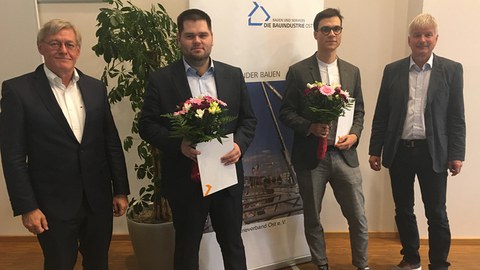
Der „Preis der Bauindustrie Sachsen“ für herausragende Abschlussarbeiten im Bereich des Bauingenieurwesens und der Architektur geht 2020 an Iurii Vakaliuk (Institut für Massivbau, TU Dresden) und Robert Bretschneider (TU Dresden).
The "Preis der Bauindustrie Sachsen 2020" in the field of civil engineering was awarded to Iurii Vakaliuk from the Institute of Concrete Structures at TU Dresden for his master's thesis on "Conceptual development for the arrangement of modular textile-reinforced macrocells".
Finck explains: "The thesis in the field of civil engineering shows a very good concept for reducing overall construction costs, in particular for reducing the material volume of concrete. The "Prize of the Construction Industry Saxony", which is awarded every two years, is endowed with 2,000 euros.
Kurt Beyer Prize 2018
What do an underwater concrete pressure housing for deep-sea exploration and an airship hangar for the construction of zeppelins have in common? Both are the topics of extraordinary dissertations that were awarded the Kurt Beyer Prize at TU Dresden on May 22, 2019.
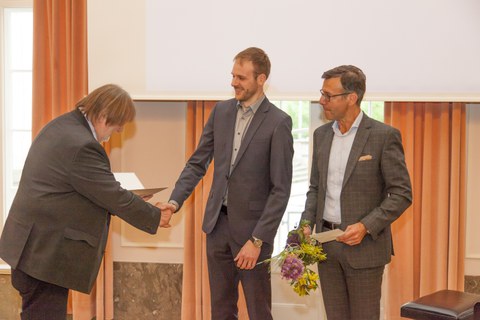
Der Prorektor für Forschung der TU Dresden, Prof. Dr. rer. nat. habil. Gerhard Rödel und Dipl.-Ing. Adrian Diaconu von der Hochtief Infrastructure GmbH NL Deutschland Südost gratulieren Dr. Sebastian Wilhelm.
In his dissertation (Use of UHPC pressure housings to protect against extreme environmental conditions in the deep sea (grade: "summa cum laude", supervisor: Prof. Manfred Curbach, Faculty of Civil Engineering at TUD)), Dr. Sebastian Wilhelm investigated how ultra-high performance concrete is suitable for underwater pressure housings. The aim was to create a cost-effective and durable alternative to expensive titanium housings. Underwater pressure housings are used to explore the deep sea - a world rich in mineral resources that is considered more unknown than the moon. At the Institute of Concrete Structures, he developed a reclosable pressure housing made of UHPC for use at depths of up to 3,000 m and analyzed the time-dependent material behavior, permeability and durability of UHPC, among other things. The tests were simulated numerically. Dr. Wilhelm calibrated a material model law from the measurement data. He was able to prove that concrete pressure housings with a wall thickness of 35 mm and an outer diameter of 250 mm can even withstand a pressure of 60 MPa, which corresponds to a water depth of 6000 m, for a short time. In practice, Dr. Wilhelm has already been able to carry out a one-year deep-sea field study in the Arctic with the pressure housing.
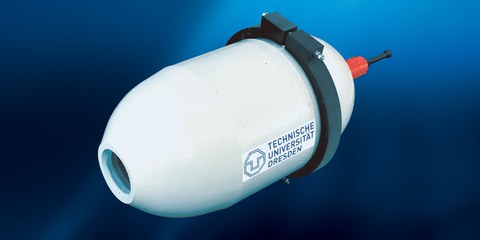
Betondruckgehäuse mit verklebter Saphirglasscheibe
Alongside Dr. Sebastian Wilhelm, Dr. Roland Fuhrmann was awarded the Kurt Beyer Prize 2018 for his dissertation "Dresden's gateway to the sky - The first aerodynamically shaped airship hangar and its influence on the history of construction".
The Kurt Beyer Prize was awarded at a ceremony on May 22, 2019 in the University Executive Board's ballroom at Mommsenstraße 11. The EUR 5,000 Kurt Beyer Prize was awarded for the 23rd time this year. Since 1996, HOCHTIEF Infrastructure GmbH has donated the endowment for this prize, which honors outstanding TUD graduates or doctorates in Civil Engineering or Architecture. The sponsor has so far provided more than 100,000 euros in prize money.
Carl Friedrich Gauss Medal 2019
The Braunschweigische Wissenschaftliche Gesellschaft (BWG) is awarding the Carl Friedrich Gauss Medal 2019 to Prof. Dr-Ing. Dr.-Ing. E.h. Manfred Curbach, Director of the Institute of Concrete Structures at TUD Dresden University of Technology, in recognition of his achievements and services in the research and application of new building materials and construction methods for concrete construction.
Manfred Curbach is one of the outstanding construction researchers of his time. He has made outstanding contributions to the development of construction technology in concrete construction.
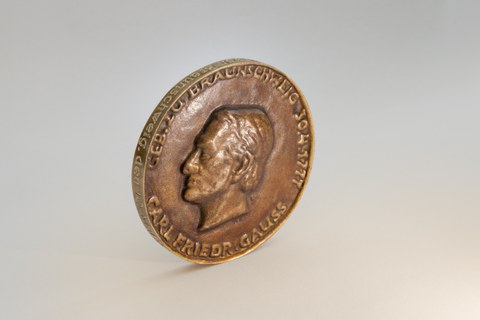
Carl-Friedrich-Gauß-Medaille 2019
Significant modern developments such as textile-reinforced concrete construction, the paradigm shift in concrete construction from "heavy, bulky, dull" to "filigree, light, elegant" and the current research into carbon reinforcement in concrete construction instead of steel reinforcement can be attributed to his impulses, his creativity and his inspiring powers of persuasion.
Manfred Curbach has an impressive ability to conceive and realize pioneering research topics, communicate the results, implement them in construction practice and support their successful application. His work sets the course for the development of building in the future towards improved capabilities, aesthetics, resource conservation and economic efficiency.
The medal will be awarded during the BWG's Annual General Meeting on May 10, 2019 at 4 p.m. in the Dornse of the Old Town Hall of the City of Braunschweig. In the morning (9.30 a.m.) of the same day, a public scientific colloquium will be held in honor of the award winner in the Mayor's Room of the Old Town Hall with the topic "Building in 2050: Requirements, Opportunities, Ideas".
Source: Press release Braunschweig Scientific Society
„Das ist etwas, was ich an unseren Vorgängern so bewundere. In außergewöhnlichen Momenten besaßen sie einen außergewöhnlichen Mut,
um eine Idee umzusetzen.“
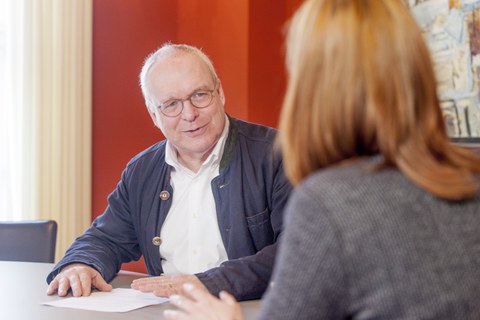
Prof. Dr.-Ing. Dr.-Ing. E. h. Manfred Curbach im Interview
Straßen asphaltieren, Wohnhäuser, Hochhäuser und Brücken bauen, bei Planungen öffentlicher Gebäude wie Sportstadien, Schwimmbädern oder Einkaufszentren beratend für die Prüfung der Statik dabei sein, vor Ort auf der Baustelle den Ton angeben – sehen so die typischen Tätigkeiten eines Bauingenieurs aus?
Eigentlich muss man dies ein wenig stärker differenzieren. Es gibt Bauwerke, bei denen Bauingenieure tatsächlich diejenigen sind, die entwerfen, die konstruieren, die rechnen und bei der Bauausführung maßgebend tätig sind. Das sind zum Beispiel Brücken, Straßen oder Industriebauwerke. Dann gibt es natürlich eine ganze Reihe von Gebäuden, bei denen sich Bauingenieur und Architekten die Arbeit teilen, z. B. bei Hochhäusern. Die Entwürfe stammen in der Regel von Architekten, die auch die Detailplanung machen. Die statische Berechnung und Konstruktion werden von Bauingenieuren durchgeführt. Die Aufgaben im Zuge der Bauleitung, Kalkulation, Abrechnung eines Bauingenieurs in einem Unternehmen finden im Büro statt. Ein weiteres wichtiges Aufgabenfeld eines Bauingenieurs ist die Kontrolle der Statik anderer als Prüfingenieur. Diese haben sich zusätzlich zur Grundausbildung zum Bauingenieur weitergebildet, bereits eine Menge Erfahrung und Kenntnisse und eine sogenannte Prüflizenz bekommen, um die Statik anderer prüfen zu können. Dann haben wir viele Bauingenieure in der öffentlichen Verwaltung, die Ausschreibungen vorbereiten, frühe Planungsphasen begleiten und natürlich hinterher auch kontrollieren, ob das gebaut wurde, was sie bestellt haben und auch abnehmen. Und dann gibt es noch Bauingenieure in der Wissenschaft.
Inspiriert durch die Schweizer Bauingenieure Robert Maillart und Christian Menn, bildeten Langlebigkeit, Ästhetik, Leichtigkeit und Ressourcenschonung das Tragwerk Ihrer damaligen Zukunftsvision. Wie hat sich diese Zukunftsvision entwickelt?
Anfang der 1980er Jahre war ich für einen Auslandskurs in Princeton/USA und der dortige Gastprofessor war Christian Menn, damals Professor an der ETH Zürich. Als ich dort war, hielt er gerade eine Vorlesungsreihe und hat z.B. über die Brücken von Robert Maillart geredet, aber natürlich auch über seine eigenen Ideen (Anmerkung der Redaktion: Christian Menn erhielt 1998 ebenfalls die Gauß-Medaille) Er hat mich, was Entwurf und Konstruktion von Brücken angeht, sehr geprägt. Herr Menn hatte ziemlich radikale Ideen. Das begann damit, dass er sagte „Eine schöne Brücke zu bauen muss nicht teurer sein als eine schlecht gestaltete Brücke“. Man braucht also nicht Geld um schön zu bauen, sondern eher Geist. Jede Brücke verlangt nach ihrem eigenen Stil in Abhängigkeit von der Umgebung, in der sie gebaut wird. Und es muss immer ein Gleichgewicht geben, nicht nur zwischen den Kräften – das ist selbstverständlich – auch zwischen der Struktur, der Form und der Last, die abgetragen werden soll. Das ist nicht automatisierbar, das kann kein Computer. Ich sehe nur, das eben sehr viel gebaut wird, was diesen Regeln nicht unbedingt entspricht. Es gibt eine Art Standard-Querschnitt und Standard Statisches System, das gerne immer wieder angewendet wird und teilweise zu durchaus plumpen Brücken führt.
Bleiben wir beim Brückenbau: Welche Ziele stehen bei Ihnen noch auf der Agenda?
Wenn ich mir meine eigenen Brücken so anschaue, dann hält sich das schwer in Grenzen. Meine Wirkung ist oft eher eine mittelbare. Studierende so auszubilden, dass sie dieses Bewusstsein möglichst frühzeitig mitbekommen und dann in Zukunft hoffentlich schönere Brücken bauen. Da würde ich mich eher als Lehrer sehen und weniger als Ausführender.
Termine, Meetings, Dienstreisen, Konferenzen, Abstimmungen – was motiviert sie und wie gelingt Ihnen dieser Kraftakt?
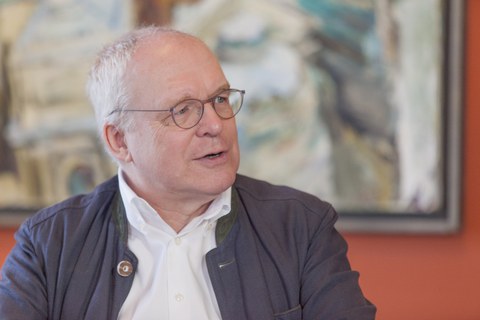
Prof. Dr.-Ing. Dr.-Ing. E. h. Manfred Curbach im Interview
Das ist schwer zu beantworten! Ein Grund könnte sein, der aber gleichzeitig ein großes Handicap ist, dass ich mich für sehr viele Dinge interessiere. Wenn man neugierig ist, dann möchte man wissen was Kollegen und Mitarbeiter auf dem Herzen haben. Sie haben alle auch gute Ideen und es wäre natürlich schade wenn das hinten herunterfallen würde. Es ist diese Neugier als Grundeigenschaft, deswegen auch Geschichte und zukünftige Materialien in einem. Wir haben ein wichtiges Forschungsvorhaben am Institut zur Geschichte eines zu Unrecht nicht so bekannten Bauingenieurs, der hier in Dresden gewirkt hat – Willy Gehler. Er ist nach dem 2. Weltkrieg fast in Vergessenheit geraten, er durfte nicht mehr erwähnt werden, hat aber in der ersten Hälfte des Jahrhunderts unglaubliche Leistungen erbracht, von den wir heute noch zehren. Auf der anderen Seite versuchen wir ein Material zu entwickeln, das die Zukunft bestimmt – den Carbonbeton.
Welches bestehende Bauwerk auf der Welt begeistert Sie besonders und warum?
Es gibt so einige Brücken von Maillart, die fast so vollkommen sind, dass sie heute noch mit den vorhandenen Materialien kaum nachgebaut werden können. Mit hochfestem Beton oder mit Carbonbeton schaffen wir es vielleicht wieder, so schöne schlanke Brücken zu bauen. Das hat Maillart damals mit dem ordinären Stahlbeton geschafft. Die Salginatobelbrücke wird von vielen gern als besonderes Bauwerk benannt. Eine, die mich schon immer fasziniert hat, ist die Brooklyn Bridge in New York. Und das eigentlich mehr aufgrund der Historie und der damaligen Bedeutung. Entworfen wurde sie von Johann Roebling, geboren in Mühlhausen in Thüringen, oder wie er später in den USA hieß John August Roebling. Mit etwa 25 Jahren ist er ausgewandert. Im Staat New Jersey hat er angefangen eine Fabrik zum Spinnen von Seilen aufzubauen. Er war wirtschaftlich schnell erfolgreich. Dann kam er auf die Idee, diese Seile im Brückenbau zu verwenden und hat einige Brücken gebaut, z. B. in Pittsburgh oder die erste dauerhafte Eisenbahn- und Straßenbrücke über den Niagara River. Sein größter Entwurf war dann die Brooklyn Bridge, den er noch selber angefertigt hatte. Zur Fertigstellung 1883 war sie die am weitesten gespannte Hängebrücke weltweit, auf Mauerwerkstürmen aufgehängt mit einer ganz leichten Fahrbahn aus Metall und Holz. Nach seinem Tod hat sein Sohn Washington, ebenfalls Bauingenieur, die Brücke weiter gebaut. Das ist eine Brücke, die so eng mit der Familie Roebling verbunden ist und eine solche Leistung für die damalige Zeit darstellt. Technisch ist ja inzwischen vieles möglich. Aber damals ohne die Kenntnisse eine derartige Brücke zu bauen, erfordert einen ungeheuren Mut. Das ist etwas, was ich an unseren Vorgängern so bewundere. In außergewöhnlichen Momenten besaßen sie einen außergewöhnlichen Mut, um eine Idee umzusetzen.
Wenn Sie eine Brücke Ihrer Wahl bauen dürften – wie sieht sie aus, wo steht sie und wen verbindet sie miteinander?
Was uns jetzt gerade umtreibt sind Brücken aus Carbonbeton, die den Vorteil haben, dass sie deutlich weniger Beton brauchen und damit erheblich schlanker sein können. Ich wünsche mir, dass es irgendwann mal Brücken aus Carbonbeton gibt, die in der Tradition von Robert Maillart stehen. Er baute schon vor über 100 Jahren Brücken, die diese Schlankheit aufweisen und letztlich auch die Dauerhaftigkeit, die mit dem Carbonbeton noch größer sein könnte. Wo sie einmal stehen könnte weiß ich nicht, denn es muss den richtigen Ort geben. Man musst erst den Standort sehen, um sagen zu können, welche Brücke an diese Stelle passt. Brücken verbinden Menschen miteinander.
Seit rund 25 Jahren entwickeln Sie Carbonbeton mit, um den globalen Herausforderungen unserer Zeit wie Bevölkerungswachstum und nachhaltiges Wirtschaften mit Ressourcen zu begegnen. Woher kommt diese Faszination für Carbonbeton und wie ist es Ihnen möglich, diese seit so langer Zeit aufrecht zu erhalten?
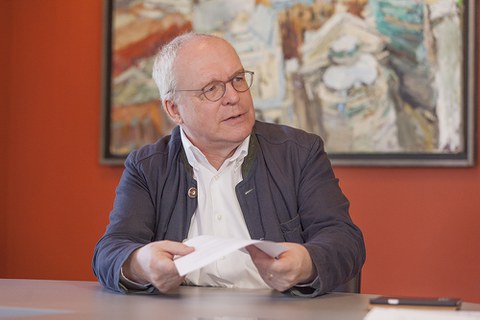
Prof. Dr.-Ing. Dr.-Ing. E. h. Manfred Curbach im Interview
Als das vor 25 Jahren begann, ahnte ich noch nicht, welche Ausmaße das annehmen kann. Aber mir war sofort klar, dass dies eine Kombination ist, die Zukunft hat. Wir haben damals bei Sanierungsmöglichkeiten mit dünnen Schichten eine Nische gesehen. Das es dann über die Jahre immer mehr wurde, überrascht mich nach wie vor. Mittlerweile würde ich sagen, dass der Carbonbeton das Zeug hat, den Stahlbeton in einem beträchtlichen Anteil zu ersetzen. Das erklärt vielleicht ein bisschen, weshalb wir da immer noch daran arbeiten. Es gibt einen Druck hinter dem Ganzen, weil wir mit dem Stahlbeton nicht so weiter bauen können wie bisher. Das verbraucht viel zu viele Ressourcen. Sand wird mittlerweile knapp, auch in Deutschland. Selbst an Orten, an denen wir noch Sand haben, darf man ihn nicht abbauen. Das heißt, wir müssen mit dem Material, was wir haben, sehr viel sparsamer umgehen. Da wir aber nicht weniger u. a. aufgrund der Bevölkerungsentwicklung bauen können, bleibt uns nichts Anderes übrig, als etwas wie Carbonbeton zu verwenden.
Das Dresdner Brückenbausymposium findet 2020 bereits zum 30. Mal statt. Gibt es dann eine große Torte aus Carbonbeton? Spaß beiseite – was ist für das Jubiläum geplant, gibt es da bereits Ideen?
Wir hatten vor vier Jahren das 25-jährige. Das haben wir ein bisschen gefeiert. Der Tagungsband war statt dem gängigen TUD-Blau in Silber. Zum 50. können dann die Veranstalter vielleicht einen goldfarbenen Umschlag wählen. Für das 30. ist bisher nichts Größeres geplant. Am Vorabend wird bereits zum 8. Mal der Deutsche Brückenbaupreis verliehen. Dieser wird alle zwei Jahre vergeben und ist mittlerweile auch schon wieder zu einer kleinen Tradition geworden.
Die Gauß-Medaille, benannt nach dem Braunschweiger Mathematiker, der in jüngerer Zeit auch den 10 DM-Schein schmückte. Was bedeutet diese Auszeichnung für Sie, die bereits zum 70. Mal verliehen wird?
Das kann ich am ehesten daran festmachen, wenn ich schaue, wer den Preis bisher bekommen hat. Diese Medaille richtet sich ja an fast alle Wissenschaftsbereiche. Letztes Jahr war es der Verfassungsrichter Paul Kirchhof, 2017 die Meeresforscherin Antje Boetius, 1998 Christian Menn – ich empfinde das als sehr, sehr große Auszeichnung, in diese Gruppe von Menschen mit aufgenommen zu werden.
Das Interview führten Diana Uhlmann und Stefan Gröschel
"Building Technology Innovation Award 2019" of the DBV
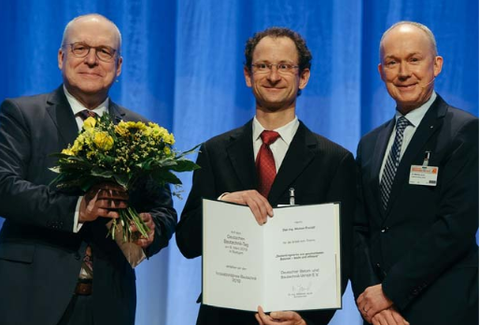
Photo shows the winner of the "Innovationspreis Bautechnik 2019", Dipl.-Ing. Michael Frenzel, with DBV chairman Dr. Jacob (right) and chairman of the jury Professor Curbach (left) at the award ceremony on 8 March 2019 in Stuttgart
Michael Frenzel from the TUD Dresden University of Technology wins the DBV's "Innovationspreis Bautechnik 2019" Dipl.-Ing. Michael Frenzel is the winner of this year's "Innovationspreis Bautechnik", which was awarded by the Deutscher Beton- und Bautechnik-Verein E.V. (DBV) in Stuttgart on March 8, 2019. With his research work "Floor structures made of layered concretes - light and efficient" and his well-founded presentation, Michael Frenzel convinced the jury at the "Colloquium for Young Engineers" on March 7, 2019 in Stuttgart and thus won the "Innovation Award for Structural Engineering 2019". In order to promote young students and doctoral candidates in particular, the German Concrete and Construction Technology Association E.V. (DBV) donates the "Innovation Award for Construction Technology" every two years, which is awarded at the German Construction Technology Day. The certificate was presented by DBV Chairman Dr. Matthias Jacob together with Professor Manfred Curbach, Chairman of the jury, on 8 March 2019 in Stuttgart. The prize is endowed with prize money of €2,500. Concrete ceilings are usually constructed with high material and energy consumption. Michael Frenzel is developing cross-section and shape-optimized constructions as part of his dissertation at the TUD Dresden University of Technology in order to be able to manufacture ceiling structures in a weight-reduced and resource-saving manner. However, he not only considered the efficient load-bearing behavior in his work "with a high degree of creativity", but also the aesthetics. Michael Frenzel completed his research work under Professor Manfred Curbach at the Institute of Concrete Structures at TUD Dresden University of Technology. The dissertation is based on his research work within the sub-project "Lightweight floor structures made of layered high-performance concretes" of the DFG-funded priority program SPP 1542 "Lightweight construction with concrete".
A total of 11 civil engineers presented their master's thesis or dissertation on March 7, 2019 in the "Colloquium for Young Engineers" and answered the questions of the jury. Michael Frenzel came out on top from this strong field of applicants.
Jury
Chairman Prof. Dr.-Ing. Dr.-Ing. E.h. Manfred Curbach,
TUD Dresden University of Technology
Members of the jury
- Dr.-Ing. Hubert Bachmann, Ed. Züblin AG
- Prof. Dr.-Ing. Harald Garrecht, University of Stuttgart
- Dr.-Ing. Julian Meyer, HOCHTIEF Engineering GmbH
- Prof. Dr.-Ing. Christoph Motzko, Technical University of Darmstadt
- Dipl.-Ing. (FH) Franz Josef Zweier, Max Bögl Stiftung & Co. KG
Source: DEUTSCHER BETON- UND BAUTECHNIK-VEREIN E.V.
Emil Mörsch Memorial Coin 2019
Founded in 1898, the German Concrete and Construction Technology Association E.V. (DBV) honored Prof. Dr.-Ing. Dr.-Ing. E.h. Manfred Curbach with the Emil Mörsch Memorial Medal, the association's highest award, on March 7, 2019. The award was presented by the new DBV Chairman Dr. Matthias Jacob as part of the opening event of the German Construction Technology Day 2019 in Stuttgart.
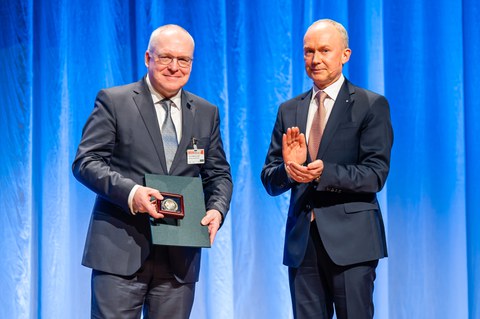
Prof. Dr.-Ing. Dr.-Ing. E.h. Manfred Curbach wird mit der Emil-Mörsch-Denkmünze ausgezeichnet.
The laudatory speech and certificate paid tribute to Manfred Curbach as follows: "As an inspiring teacher, an inspiring researcher and creative engineer, he has achieved outstanding things and given new impetus to concrete construction. He has always shared his knowledge with people in a large number of national and international professional associations and in society. Of particular importance are his innovative ideas for the development of carbon reinforced concrete, which have also received remarkable recognition outside the professional world. Important contributions to the impact behavior of concrete, multi-axial stresses, solid bridge construction and the history of concrete construction round off his work. Through his work, in the tradition of Emil Mörsch, he has enhanced the reputation of civil engineers in professional circles and society far beyond Germany's borders."
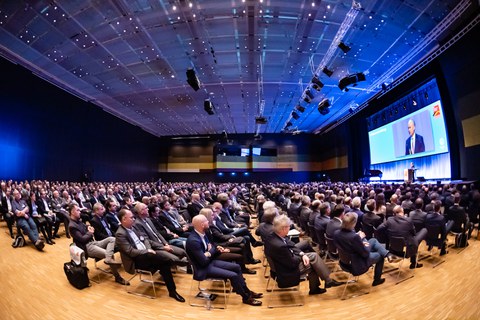
Eröffnungsveranstaltung DEUTSCHER BAUTECHNIK -TAG 2019
Born in Dortmund in 1956, Manfred Curbach began studying Civil Engineering at the University of Dortmund in 1977 and graduated in 1982. A scholarship from the German National Academic Foundation took him to Princeton University in the USA. In 1987, Manfred Curbach was awarded a doctorate in engineering by Professor Eibl in Karlsruhe. This was followed by a move into practice at the engineering firm Köhler + Seitz in Nuremberg from 1988 to 2004. In 1994, he was appointed Chair of Concrete Structures at the TUD Dresden University of Technology.
Manfred Curbach's core research areas are the material behavior of concrete under high load velocities and the behavior of concrete components under short-term dynamics. He also researches the multi-axial strength of concrete and the composite behavior between high-performance concrete and reinforcing steel under fatigue loading. In 2011, he was awarded an honorary doctorate by the Technical University of Kaiserslautern for his achievements in these fields in particular. Numerous other prizes and awards followed in his career.
Since 2013, Manfred Curbach has been spokesman for the BMBF consortium C³ - Carbon Concrete Composite. His vision is nothing less than a new way of building using carbon concrete. To this end, he devised, applied for and won over more than 160 partners for a research project with a total volume of almost 70 million euros. And Manfred Curbach has managed to present this topic in such a way that not only the specialist public learns about it. In 2016, he was awarded the "German Future Prize, Federal President's Prize for Technology and Innovation", beating off competition from the automotive industry, among others.
In addition to his professional qualities, his winning and human qualities were also recognized. As a passionate teacher and genuine team player, Manfred Curbach shares his knowledge in numerous honorary positions and is consequently a member of the German National Academy of Sciences Leopoldina, for example.
Manfred Curbach thanked the DBV for the "huge award" as well as his colleagues and the TUD Dresden University of Technology for their cooperation and support. He called on the next generation of engineers to take responsibility and go their own, new ways.
Since 1938, the DBV has donated the Emil Mörsch Memorial Medal every two years to honor personalities who have distinguished themselves through special achievements in the field of concrete construction and have promoted this type of construction.
2019 Manfred Curbach
2017 Jürgen Schnell
2015 Karl Morgen
2013 Hans-Wolf Reinhardt
2011 Holger Svensson
2009 Konrad Zilch
2007 Theodor Baumann
2005 Peter Schießl
2003 Wieland Ramm
2001 Gert König
1999 Josef Eibl
1997 Hubert K. Hilsdorf
1995 Jörg Schlaich
1993 René Walther
1991 Herbert Kupfer
1989 Franco Levi
1987 Volker Hahn
1985 Hanno Goffin
1983 Karl Kordina
1981 Hans Wittfoht
1979 Ben C. GerwickJr.
1977 Wolfgang Zerna
1975 Pieter Blokland
1973 Kurt Walz
1971 Hans Minetti
1969 Nicolas Esquillan
1967 Fritz Leonhardt
1965 Hermann Bay
1963 Pier Luigi Nervi
1961 Ludwig Lenz
1959 Eugène Freyssinet
1957 Hubert Rüsch
1956 Alfred Hummel
1955 Bruno Hampe
1954 Max Lütze
1953 Ulrich Finsterwalder
1952 Bernhard Wedler
1951 Adolf Kleinlogel
1950 Willy Gehler
1949 Walter Nakonz
1944 Karl Schaechterle
1943 Leopold Ellerbeck
1942 Fritz von Emperger
1941 Otto Graf
1940 Franz Dischinger
1939 Fritz Todt
1938 Emil Mörsch
Source: DEUTSCHER BETON- UND BAUTECHNIK-VEREIN E.V.
Wackerbarth Medal 2018
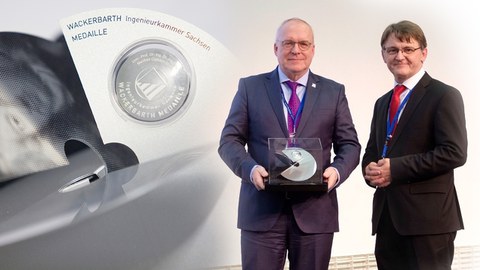
Prof. Manfred Curbach (links im Bild) erhält die Wackerbarth-Medaille von Prof. Dr.-Ing. Hubertus Milke, Präsident der Ingenieurkammer Sachsen.
Prof. Manfred Curbach, Director of the Institute of Concrete Structures at TU Dresden, received the "Wackerbarth Medal" at the 2018 Chamber of Engineers Day.
With this award, the Chamber of Engineers of Saxony honors his many years of scientific work, which is recognized beyond the borders of the Federal Republic of Germany, as well as his commitment to the internationally recognized bridge construction symposium.
Dresden Congress Award 2018
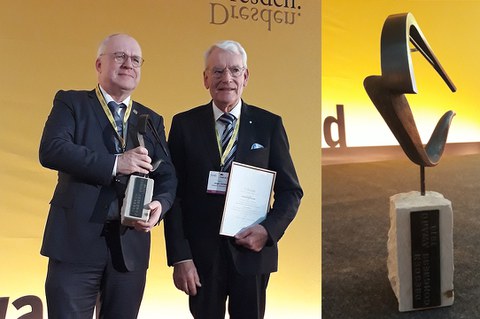
Prof. Manfred Curbach (links im Bild) und Prof. Jürgen Stritzke erhalten den Dresden Congress Award für das 28. Dresdner Brückenbausymposium 2018.
Professor Jürgen Stritzke launched a congress on bridge construction in Dresden back in 1991. The 29th Dresden Bridge Building Symposium (DBBS) will take place in March next year.
Since its inception, the DBBS has always seen itself as a multiplier of good ideas, interesting innovations and promising technologies and has developed into the largest event of its kind in the German-speaking world and is an ideal meeting place for the exchange of experience on the planning, construction, repair and upgrading of bridges for all those involved and interested in construction. This commitment to the large family of bridge builders and also to Dresden as a congress location was recognized on 15 November 2018 with the Dresden Congress Award in the continuity category.
The Dresden Congress Award - also known as the "Oscar of the congress industry" - honours committed scientists, entrepreneurs and congress organizers who have brought congresses and conferences to Dresden and successfully organized them.
Award ceremony Wolfgang Dürr Foundation in conjunction with WOLFF & MÜLLER Personalentwicklung GmbH 2018
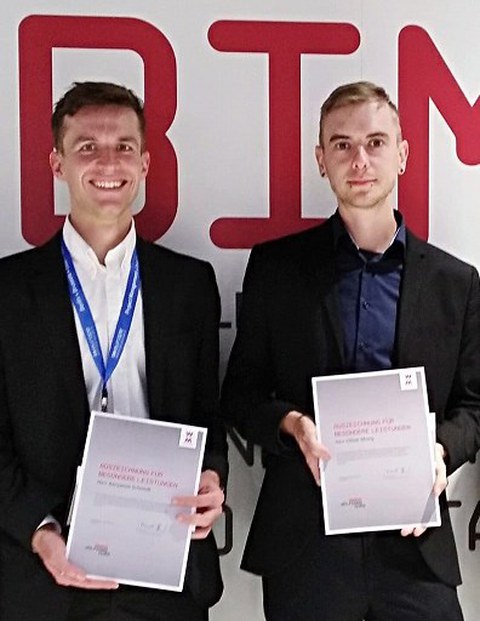
Benjamin Schmidt (links) und Oliver Mosig zur Preisverleihung in München
On October 10, 2018, at EXPO REAL (International Trade Fair for Real Estate and Investment) in Munich, two graduates from our faculty - Mr. Oliver Mosig and Mr. Benjamin Schmidt - received an award from the Wolfgang Dürr Foundation in conjunction with WOLFF & MÜLLER Personalentwicklung GmbH for their first-class academic achievements and, in particular, outstanding theses, with prize money of 1000 euros each.
German Future Prize 2016
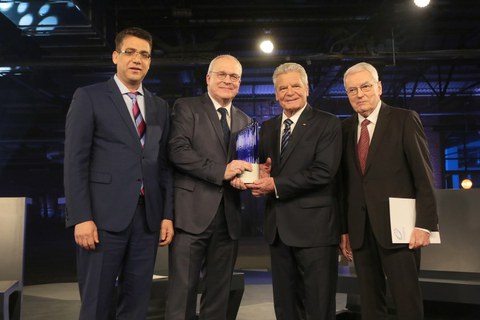
Die Dresdner Professoren Manfred Curbach, Chokri Cherif und Peter Offermann sind die Gewinner des Deutschen Zukunftspreises 2016.
Dresden professors Manfred Curbach, Chokri Cherif and Peter Offermann are the winners of the German Future Prize 2016. Federal President Joachim Gauck presented the prize, which is endowed with 250,000 euros, on November 30 in Berlin. The TU Dresden research team was one of the three finalists and successfully beat its competitors. "For the first time in the history of the award ceremony, a team from the field of civil engineering was honored. This shows us how important our research and our efforts are in bringing about the urgently needed paradigm shift in the construction industry towards greater resource efficiency and sustainability," said Chair of Concrete Structures at TU Dresden and spokesperson for the winning team, Manfred Curbach. The German President's Future Prize is one of the most important science prizes in Germany. The Rector of TU Dresden, Prof. Hans Müller-Steinhagen, is particularly pleased: "Congratulations! This is a great success for the three professors, for TU Dresden and also for Dresden as a science location. This is the second time since 2011 that scientists from our university have succeeded in making the development of pioneering innovation comprehensible, starting with the idea and basic research through to the market launch, thus convincing the high-caliber jury of the Deutscher Zukunftspreis."
The three researchers at TU Dresden developed a new composite material that uses carbon instead of steel reinforcement. Carbon is four times lighter and six times stronger than steel. The potential of this innovative composite material is immense. In contrast to reinforced concrete, carbon concrete is more resistant and at the same time more durable, as it does not rust. Components and structures can be constructed thinner, which saves valuable resources such as water and sand. The material also allows for delicate shapes and a wide range of applications. Material savings of more than 50 percent are possible when using carbon concrete. This also goes hand in hand with a reduction in energy consumption andCO2 emissions. The development progress is also in the detail. Components made of carbon concrete can be combined with additional functions such as insulating, heating or monitoring buildings. Carbon concrete can not only be used in new buildings. The material is also ideal for reinforcing existing structures. The service life of buildings, bridges and masts can be significantly increased by applying a thin layer of carbon concrete. Since 2006, old buildings in Germany and around the world, such as a department store in Prague or huge silos such as the sugar silos in Uelzen, have been reinforced using this method. The building material carbon reinforced concrete is therefore not only an innovation for Dresden, but is becoming increasingly important worldwide.
The Federal Ministry of Education and Research has also recognized the importance of carbon concrete technology and is funding the association C³ - Carbon Concrete Composite e. V., founded in 2014, with up to 43 million euros. C³ e. V. is an interdisciplinary network of more than 150 partners from the fields of business, science and associations who are working together to promote the introduction of the material on the market.
Gottfried Brendel Prize 2016
The Gottfried Brendel Prize, endowed with 3,000 euros, is sponsored by one of the leading companies in the industry, Bilfinger SE. On October 28, 2016, the jury decided on two equal first prizes and a special prize, which were awarded by Dr. Horst Arnold. The winners were Kristina Farwig from the Institute of Concrete Structures for her work "Renovation of timber beam ceilings in timber-concrete composite construction" and Cäcilia Karge from the Institute of Steel and Timber Construction for her work "Design and dimensioning of a pedestrian and cyclist bridge over the Datteln-Hamm Canal and the River Lippe in Hamm". The special prize was awarded to Peter Friedrich from the Faculty Computing Center (FRZ) for his work "Normal vector-based methods of sensitivity analysis for the validation of models of the failure interfaces of triaxial concrete load tests".
Kurt Beyer Prize 2016
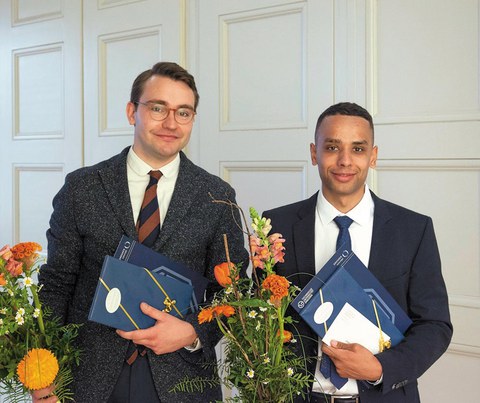
Die glücklichen Preisträger: Maximilian Kunze (li.) und Alexander Schumann (re.)
On April 21, 2017, the Kurt Beyer Prize 2017 was awarded in the University Executive Board's ballroom. One graduate each from the Faculty of Architecture and the Faculty of Civil Engineering received the prize, which is endowed with 2500 euros, for their outstanding theses.
Dipl.-Ing. Alexander Schumann from the Institute of Concrete Structures developed a design for a self-supporting hall made of carbon concrete as part of his thesis. Slender and filigree load-bearing elements can be designed using carbon concrete. In addition to being used for façade elements and reinforcement measures for existing buildings, carbon concrete is predestined for filigree new structures, especially load-bearing structures such as shells, folded structures, lattice shells, etc. The hall designed by Alexander Schumann has a column-free roof in the form of a double-curved shell with a clear room height of 8 meters. It is made of individual prefabricated textile concrete segments, diamond-shaped rods and a stiffening textile concrete layer between the individual diamonds.
The result is a visually appealing design consisting of a slender and filigree load-bearing structure that can be completely prefabricated. The design shows that a shift away from solid construction towards lightweight and energy-efficient construction can be achieved through the use of carbon concrete.
Kurt Beyer Prize 2015
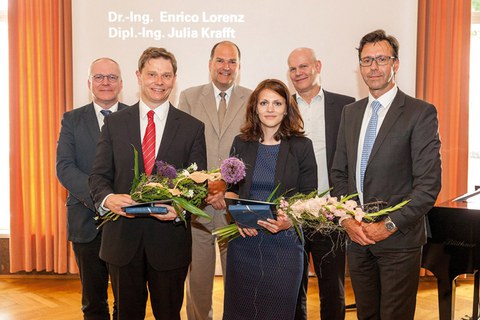
Die beiden Preisträger des Kurt-Beyer-Preises 2015 im Kreis der Laudatoren
The Kurt Beyer Prize was awarded for the 20th time on June 10, 2016. The winners of 2015 are Dr.-Ing. Enrico Lorenz from the Institute of Concrete Structures in the Faculty of Civil Engineering, who received the prize for his dissertation "End anchoring and overlapping of textile reinforcements in concrete matrices", and Dipl.-Ing. Julia Krafft from the Faculty of Architecture for her thesis "Grenzwertig - Segelflugzentrum Lemwerder".
Enrico Lorenz carried out meticulous scientific research into the interaction between the concrete matrix and the textile carbon reinforcement. In order to find out how the textile reinforcement can be securely anchored in the concrete and under what conditions it can be prevented from pulling out of the concrete matrix, he had to enter uncharted scientific territory. He did so unerringly and, as his doctoral supervisor Prof. Manfred Curbach emphasized, with a combination of theoretical basis, experimental soundness and practical applicability in construction. "This triumvirate distinguishes Enrico Lorenz's work in particular," said Prof. Curbach.
Kurt Beyer Prize 2014
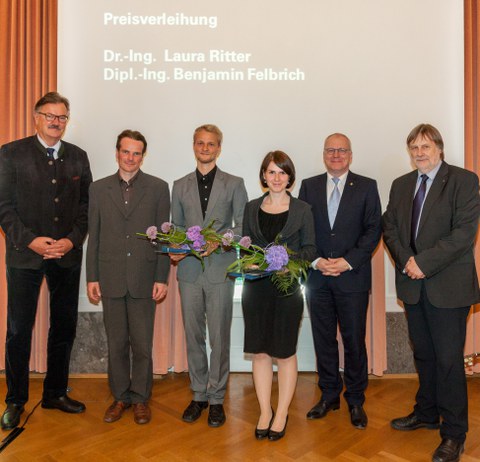
Preisverleihung – mit (v.l.n.r.) Dipl.-Ing. Stephan Otto vom Preis-Stifter HOCHTIEF, Dr.-Ing. Jörg Nönnig, Dipl.-Ing. Benjamin Felbrich, Dr.-Ing. Laura Ritter, Prof. Manfred Curbach und dem Prorektor für Forschung, Prof. Gerhard Rödel.
The Kurt Beyer Prize has been awarded for 19 years - for the best in the fields of Architecture and Civil Engineering. On May 22, 2015, Dr.-Ing. Laura Ritter and Dipl.-Ing. Benjamin Felbrich were the 43rd and 44th winners to receive the prize donated by HOCHTIEF at a ceremony in the University Executive Board.
Laura Ritter received her doctorate from the Faculty of Civil Engineering, her award-winning topic was "The influence of transverse tension on the bond between concrete and reinforcing steel". The laudator during the ceremony was also the supervisor of the thesis: Prof. Manfred Curbach from the Institute of Concrete Structures called the work "a very important milestone in composite research" and emphasized that "Laura Ritter's research results provide an excellent basis for all further theoretical analyses in this field."
Benjamin Felbrich approached his diploma thesis with "curiosity, enthusiasm, a real thirst for discovery and a thirst for research", said his supervisor (together with Sebastian Wiesenhüter) and laudator Dr.-Ing. Jörg R. Nönnig - and added with a grin: "...and soon landed in uncertain territory!" But it was precisely this, the push towards uncertain boundaries and the exploration of what lies beyond these boundaries, that ultimately led to success. The commission was amazed and surprised at the presentation - but also convinced that what Benjamin Felbrich had initiated with his work "Bionics in Architecture - Experiments with Multiagent Systems in Irregular Folding Structures" was possibly the future of architecture.
...a future that Dipl.-Ing. (FH) Stephan Otto from Hochtief Construction GmbH did not want to ignore, but nevertheless could not resist asking in his speech: "How are we supposed to build that?" But that is often the case with forward-looking research, that you have more questions than answers right now (even though the two prizewinners had presented their work very clearly!) On the other hand, Stephan Otto was able to point to numerous respectable buildings in which HOCHTIEf is currently involved - and also mentioned that the company is very interested in outstanding young talent...
Wolfgang Zerna Medal of Honor 2014
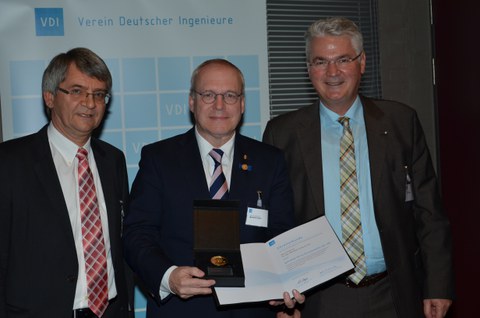
Prof. Manfred Curbach (Mitte) wurde im Beisein von Laudator Dr.-Ing. Franz-Hermann Schlüter und Prof. Wilfried Clauß, Vorsitzender der VDI-GBG, die neue Medaille verliehen.
The VDI Association of German Engineers is recognizing outstanding achievements in the field of construction technology with a new award: for the first time, the VDI Society for Construction and Building Technology presented the Wolfgang Zerna Medal of Honour at its annual conference. The award winner is Prof. Dr.-Ing. Manfred Curbach from TU Dresden.
Curbach was honored for his outstanding scientific achievements in the field of building technology. Franz-Hermann Schlüter, member of the Advisory Board for Structural Engineering, highlighted concrete construction in particular as a field of activity. Manfred Curbach was Chairman of the former VDI Society for Structural Engineering from 2003 to 2008. During his term of office, the first VDI student competition for the planning of a bridge over the Rhine was held.
The Wolfgang Zerna Medal of Honor of the VDI is awarded by the VDI Society for Construction and Building Technology in recognition of the outstanding and exemplary personality of its namesake. It honors particularly deserving members and voluntary workers or engineers who have rendered outstanding services in the field of construction technology.
The Wolfgang Zerna Medal of Honor of the VDI is a minted gold coin. On the obverse, it bears the portrait of Wolfgang Zerna, his name, year of birth and death and the inscription "VDI - Bautechnik"; the reverse and the miniature version are identical to the VDI Medal of Honor. The new award is equivalent to the Medal of Honor and the Hermann Rietschel Medal of Honor of the VDI.
Source: VDI Association of German Engineers | Press
Kurt Beyer Prize 2013
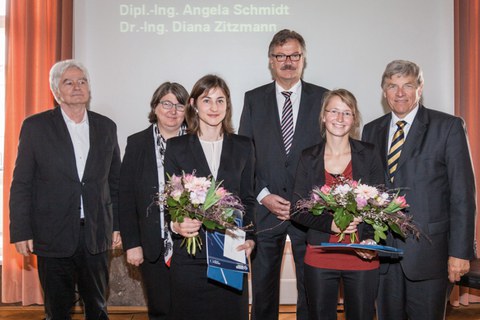
Stephan Otto, Angela Schmidt, Prof. Rainer Schach (v.l.n.r.).
The Kurt Beyer Prize 2013 was awarded on March 21, 2014 in the ballroom of the University Executive Board. The prizewinners are Dipl.-Ing. Angela Schmidt from the Institute of Concrete Structures, Faculty of Civil Engineering, and Dr.-Ing. Diana Zitzmann, Faculty of Architecture.
Angela Schmidt received the prize for her diploma thesis "Form optimization of columns". She had already dealt with the shape optimization of columns as part of her project work in the 9th semester. She had already been awarded the Brendel Prize for this in 2013. Angela Schmidt remained true to the topic of her project work by expanding on it in her dissertation. "In both theses, Ms. Schmidt proved in an outstanding way that she is able to familiarize herself with difficult topics and issues that are unfamiliar to students and solve them excellently," said the Dean of the Faculty of Civil Engineering, Prof. Rainer Schach, in his laudatory speech.
The Kurt Beyer Prize is endowed with a total of 5,000 euros and the prize was split equally. There were a total of ten entries to choose from - six from the Faculty of Civil Engineering and four from the Faculty of Architecture. The two prizewinners presented their work at the award ceremony; the prize was presented by Dipl.-Ing. (FH) Stephan Otto from HOCHTIEF Solutions AG, Civil Engineering and Traffic Infrastructure, which has sponsored the prize since 2011 (previously it was sponsored by HOCHTIEF Construction AG since 1996).
Leopoldina certificate for Prof. Manfred Curbach 2013
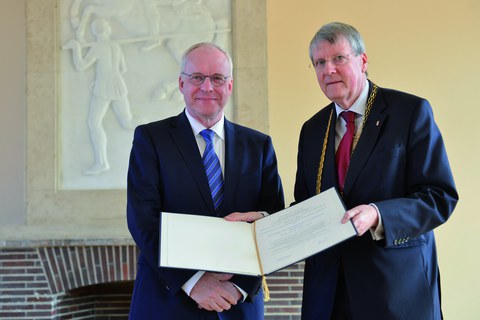
Prof. Manfred Curbach erhält seine Mitgliedsurkunde aus den Händen des Präsidenten der Nationalen Akademie der Wissenschaften Leopoldina, Professor Jörg Hacker (r.)
As part of the annual Leopoldina Class I symposium, high-ranking scientists received their membership certificates from the President of the German National Academy of Sciences Leopoldina, Professor Jörg Hacker.
Among the 15 scientists elected to Class I in 2013 is the only Dresden scientist, Prof. Manfred Curbach from the Institute of Concrete Structures at TUD Dresden University of Technology. He is a member of the Leopoldina - one of the oldest scientific academies in the world - in the Technical Sciences section.
The Leopoldina was founded in 1652 and is committed to free science for the benefit of mankind and the shaping of the future. With around 1500 members, the Leopoldina brings together outstanding scientists from Germany, Austria, Switzerland and numerous other countries.
Gottfried Brendel Prize 2013
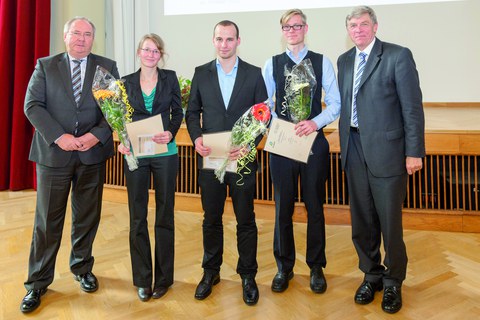
Preisverleihung beim Tag der Fakultät.
The Gottfried Brendel Prize, endowed with 3,000 euros, for special achievements in the project work of 9th semester engineering design students was presented by Harald Möller (left) on behalf of the donor Bilfinger SE during the "Faculty Day". The 2013 prize winner is Angela Schmidt for her work "Form Follows Force - Optimizing the Geometry of Columns". Two 2nd prizes were also awarded to Max Käding ("Design of a railroad bridge over the Röder") and Kevin Wahl ("Design and dimensioning of a bicycle and pedestrian bridge over the Ems near the town of Rheine"). On the right in the picture is the then Dean of the Faculty of Civil Engineering, Prof. Rainer Schach.
Kurt Beyer Prize 2012
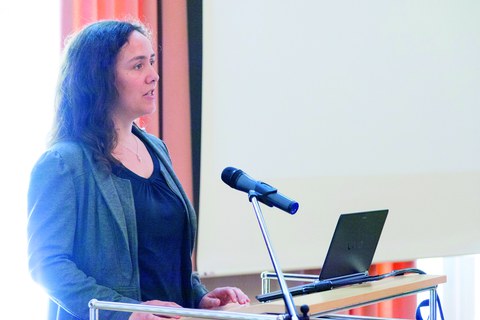
Dr.-Ing. Anett Brückner
The winners of the 2012 Kurt Beyer Prize, which has been awarded annually since 1996, are Dr.-Ing. Anett Brückner, who wrote her dissertation on "Shear force reinforcement of structural components with textile-reinforced concrete" at the Institute of Concrete Structures in the Faculty of Civil Engineering, and Dipl.-Ing. Andreas Fuchs from the Faculty of Architecture. His thesis dealt with the "Conservation and development of Seres Campill". The prize was awarded in June 2013 in the University Executive Board's ballroom.
Prof. Manfred Curbach for the Faculty of Civil Engineering and Prof. Gerald Staib for the Faculty of Architecture lauded the two prizewinners. Prof. Ursula Schaefer, Vice-Rector Academic Affairs at TU Dresden, gave the welcoming address.
The Kurt Beyer Prize is awarded at TU Dresden for outstanding final theses in the Faculties of Architecture and Civil Engineering; it is endowed with 5,000 euros. Since 2011, the prize has been awarded by HOCHTIEF Solutions AG, for whom Dipl.-Ing. Michael Pröbstl spoke during the event.

